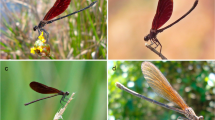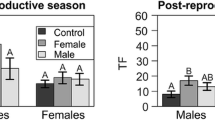Abstract
Coenagrion puella males search actively for mates and are not aggressive to other males. To study the role of visual cues in male–female discrimination, four types of models were used: (1) bodies of intact insects, (2) models of painted males, (3) models of male–female chimerae, and (4) models of female body parts. Abdomen coloration pattern and presence of wings were the most important cues for sexual recognition by males. Step-by-step elimination of male coloration pattern leads to an increase in the tandem response rate. A female model painted as a male repelled males like the intact male model. The absence of either the head or the thorax slightly decreased the number of tandem responses, but models without both the head and the thorax were not recognized as a mate. Abdomen thickness larger than that of a normal female decreased the attractiveness of the model. Models of the gynochrome female were significantly more attractive than models of the androchrome one. Female models containing male parts were less attractive than models without any structure at this place. Using principal-components analysis, it is shown that models repelling males usually were those containing an intact male abdomen or a female abdomen painted with blue. The results indicate that C. puella males can distinguish males from females visually by morphological structures and coloration pattern.
Similar content being viewed by others
REFERENCES
Andrew, C. G. (1966). Sexual recognition in adult Erythemis simplicicollis (Odonata: Anisoptera). Ohio J. Sci. 66: 613–617.
Arak, A., and Enquist, M. (1993). Hidden preferences and the evolution of signals. Phil. Trans. R. Soc. Lond. B 340: 207–213.
Battin, T. J. (1993a). Revision of the puella group of the genus Coenagrion, with emphasis on morphologies contributing to reproductive isolation (Odonata, Coenagrionidae). Hydrobiologia 262: 13–29.
Battin, T. J. (1993b). The odonate mating system, communication, and sexual selection: A review. Boll. Zool. 60: 353–360.
Bick, G. H., and Bick, J. C. (1965). Color variation and significance of color in reproduction in the damselfly Argia apicalis (Say) (Zygoptera: Coenagriidae). Can. Entomol. 97: 32–41.
Bick, G. H., and Bick, J. C. (1978). The significance of wing clapping in Zygoptera. Odonatologica 7: 5–9.
Bick, G. H., and Bick, J. C. (1981). Heterospecific pairing among Odonata. Odonatologica 10: 259–270.
Buchholtz, C. (1956). Eine Analyse des Paarungsverhaltens und der dabei wirkenden Auslöser bei den Libellen Platycnemis pennipes Pall. und Platycnemis dealbata Klug. Z. Tierpsychol. 13: 13–25.
Conrad, K. F., and Pritchard, G. (1989). Female dimorphism and physiological color change in the damselfly Argia vivida Hagen (Odonata: Coenagrionidae). Can. J. Zool. 67: 298–304.
Cordero, A. (1989). Reproductive behaviour of Ischnura graellsii (Rambur) (Zygoptera: Coenagrionidae). Odonatologica 18: 237–244.
Cordero, A. (1992). Density-dependent mating success and colour polymorphism in females of the damselfly Ischnura graellsii (Odonata: Coenagrionidae). J. Anim. Ecol. 61: 769–780.
Cordoba-Aguilar, A. (1992). Comportamiento reproductivo y polycromatismo en Ischnura denticollis Burmeister (Zygoptera: Coenagrionidae). Bull. Am. Odonatol. 1: 57–64.
De Marchi, G. (1990). Precopulatory reproductive isolation and wing colour dimorphism in Calopteryx splendens females in Southern Italy (Zygoptera: Calopterygidae). Odonatologica 19: 243–250.
Fincke, O. M. (1994). Female colour polymorphism in damselflies: Failure to reject the null hypothesis. Anim. Behav. 47: 1249–1266.
Fincke, O. M. (1997). Conflict resolution in the Odonata: Implications for understanding female mating patterns and female choice. Biol. J. Linn. Soc. 60: 201–220.
Forbes, M. R. L. (1991). Female morphs of the damselfly Enallagma boreale Selys (Odonata: Coenagrionidae): A benefit for androchrometypes. Can. J. Zool. 69: 1969–1970.
Forbes, M. R. L. (1994). Tests of hypotheses for female-limited polymorphism in the damselfly Enallagma boreale Selys. Anim. Behav. 47: 724–726.
Frantsevich, L. I. (1982). Interrelationship of key visual stimuli releasing attack and escape in dragonflies. Zh. Evol. Physiol. Bioch. 18: 150–154 (in Russian).
Frantsevich, L. I., and Mokrushov, P. A. (1984). Visual stimuli releasing attack of a territorial male in Sympetrum (Anisoptera, Libellulidae). Odonatologica 13: 335–350.
Gorb, S. N. (1992). An experimental study of refusal display in the damselfly Platycnemis pennipes (Pall.) (Zygoptera: Platycnemididae). Odonatologica 21: 299–307.
Gorb, S. N. (1994). Female perching behaviour of the libellulid dragonfly Sympetrum sanguineum L. (Anisoptera: Libellulidae) at places of feeding. Odonatologica 23: 341–353.
Gorb, S. N. (1998). Precopulatory behaviour and preference of female colour morphs by males in the damselfly Ischnura elegans (Vander Linden) (Zygoptera: Coenagrionidae). Odonatologica (in press).
Heymer, A. (1973). Etude du comportement reproducteur et analyse des méchanismes déclencheurs innés (MDI) optiques chez les Calopterygidae (Odonata, Zygoptera). Ann. Soc. Entomol. Fr. (N.S.) 9: 219–255.
Hilton, D. F. J. (1983). Mating isolation in two sympatric species of Nehalennia (Zygoptera: Coenagrionidae). Odonatologica 12: 375–380.
Hilton, D. F. J. (1987). A terminology for females with colour patterns that mimic males. Entomol. News 98: 221–223.
Hinnekint, B. O. N., and Dumont, H. J. (1989). Multi-annual cycles in populations of Ischnura e. elegans induced by crowding and mediated by sexual aggression (Odonata: Coenagrionidae). Entomol. Gen. 14: 161–166.
Hooper, R. E. (1995). Individual recognition of mates and non-mates by male Calopteryx splendens xanthostoma (Charpentier) (Zygoptera: Calopterygidae). Odonatologica 24: 347–352.
Ito, Y. (1960). Territorialism and residentiality in a dragonfly Orthetrum albistylum speciosum Uhler. Ann. Entomol. Soc. Am. 53: 851–853.
Jacobs, M. E. (1955). Studies on territorialism and sexual selection in dragonflies. Ecology 36: 566–586.
Johnson, C. (1962). A study of territoriality and breeding behavior in Pachydiplax longipennis Burm. (Odonata: Libellulidae). Southwest. Nat. 7: 191–197.
Johnson, C. (1975). Polymorphism and natural selection in ischnuran damselflies. Evol. Theory 1: 81–90.
Krieger, F., and Krieger-Loibl, E. (1958). Beiträge zum Verhalten von Ischnura elegans und Ischnura pumilio (Odonata). Z. Tierpsychol. 15: 82–93.
Loibl, E. (1958). Zur Ethologie und Biologie der deutschen Lestiden (Odonata). Z. Tierpsychol. 15: 54–81.
Martens, A. (1989). Aggregation of tandems in Coenagrion pulchellum (Van der Linden, 1825) during oviposition (Odonata, Coenagrionidae). Zool. Anz. 223: 124–128.
Martens, A. (1994). Field experiments on aggregation behaviour and oviposition in Coenagrion puella (L.) (Zygoptera: Coenagrionidae). Adv. Odonatol. 6: 49–58.
Mokrushov, P. A. (1987). The role of visual stimuli in mate recognition in dragonflies Sympetrum. Vestn. Zool. 1987(4): 52–57 (in Russian.)
Mokrushov, P. A. (1991). Visual stimuli in the dragonfly behaviour. IV. Recognition of the conspecifical motionless individuals in Lestes damselflies. Vestn. Zool. 1991(2): 39–43 (in Russian.)
Mokrushov, P. A. (1992). Visual stimuli in the dragonfly behaviour. V. Recognition of the conspecifical movable individuals in Lestes damselflies. Vestn. Zool. 1992(1): 39–45 (in Russian.)
Moodie, M. N. (1995). Evolution of Female Coloration in Damselflies, M.S. thesis, University of Oklahoma, Norman.
Parr, M., and Parr, M. (1974). Studies on the behaviour and ecology of Nesciothemis nigeriensis Gambles (Anisoptera: Libellulidae). Odonatologica 3: 21–47.
Pajunen, V. I. (1963). On the threat display of resting dragonflies (Odonata). Suomen hyonteistieteell aikakauskirja 29: 236–239.
Pajunen, V. I. (1964). Aggressive behaviour in Leucorrhinia caudalis Charp. (Odonata, Libellulidae). Ann. Zool. Fenn. 1: 357–369.
Paulson, D. R. (1974). Reproductive isolation in damselflies. Syst. Zool. 23: 40–49.
Pezalla, V. M. (1979). Behavioral ecology of the dragonfly Libellula pulchella Drury (Odonata: Anisoptera). Am. Midl. Nat. 102: 1–22.
Robertson, H. M. (1985). Female dimorphism and mating behaviour in a damselfly. Ischnura ramburi: Females mimicking males. Anim. Behav. 33: 805–809.
Robertson, H. M., and Paterson, H. E. H. (1982). Mate recognition and mechanical isolation in Enallagma damselflies (Odonata: Coenagrionidae). Evolution 36: 243–250.
Robey, C. W. (1975). Observations on breeding behaviour of pachydiplax longipennis (Odonata, Libellulidae). Psyche 82: 89–96.
Rüppell, G. (1989). Fore legs of dragonflies used to repel males. Odonatologica 18: 391–396.
Thompson, D. J. (1989a). Lifetime reproductive success in andromorph females of the damselfly Coenagrion puella (L.) (Zygoptera: Coenagrionidae). Odonatologica 18: 209–213.
Thompson, D. J. (1989b). Sexual size dimorphism in Coenagrion puella (L.) (Zygoptera: Coenagrionidae). Adv, Odonatol. 4: 123–131.
Thompson, D. J., and Banks, M. J. (1989). Short-term mating success of male Coenagrion puella (L.) (Zygoptera: Coenagrionidae). Odonatologica 18: 65–73.
Ubukata, H. (1983). An experimental study of sex recognition in Cordulia aenea amurensis Selys (Anisoptera, Corduliidae). Odonatologica 12: 71–81.
Utzeri, C. (1988). Female “refusal display” vesus male “threat display” in Zygoptera: Is it a case of intraspecific imitation? Odonatologica 17: 45–54.
Williams, C. E. (1977). Courtship display in Belonia croceipennis (Selys), with notes on copulation and oviposition (Anisoptera: Libellulidae). Odonatologica 6: 281–287.
Author information
Authors and Affiliations
Rights and permissions
About this article
Cite this article
Gorb, S.N. Visual Cues in Mate Recognition by Males of the Damselfly, Coenagrion puella (L.) (Odonata: Coenagrionidae). Journal of Insect Behavior 11, 73–92 (1998). https://doi.org/10.1023/A:1020818617066
Issue Date:
DOI: https://doi.org/10.1023/A:1020818617066




